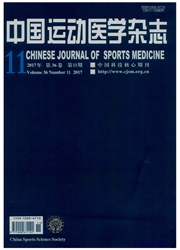

 中文摘要:
中文摘要:
目的:观察不同类型的力量训练对运动员机体内单胺类神经递质代谢物的作用,并探讨其机制,从而在无创性尿液神经递质代谢指标方面为运动训练监控提供部分科学理论依据。方法:选择北京市参加全运会的一线男子游泳运动员6名进行3个阶段(最大力量期、专项力量期和爆发力量期)的力量训练。取力量训练周期前、3个阶段力量训练期内第1次训练课后以及3个阶段力量训练期结束后24小时全尿,测量其尿肌酐及单胺类神经递质代谢物水平。结果:一次性力量训练课后的24h尿体积均显著降低(P〈0.05),而尿肌酐水平均无变化;与训练前的安静值相比,3种力量训练的一次性力量训练后尿液中香草扁桃酸(VMA)与高香草酸(HVA)均有不同程度的升高,其中最大力量训练期提高水平最多,专项力量期次之,爆发力量期最低;而一次性力量训练后尿液中的5-羟吲哚乙酸(5-HIAA)均未有显著变化;长期力量训练后受试者安静态24小时的尿体积和尿肌酐水平均无显著变化。与训练前安静值相比,长期力量训练后安静态24小时尿VMA、HVA、5-HIAA的水平均无显著变化。结论:一次性力量训练可促进尿液VMA和HVA浓度升高,提示机体儿茶酚胺(CA)的代谢水平增强,并且训练强度越大促进的效果越明显;一次性力量训练对5-HIAA代谢没有影响,提示机体5-HT的代谢水平未受影响;而长期的力量训练对尿液中单胺类神经递质代谢物的水平没有影响。
 英文摘要:
英文摘要:
Objective To investigate the effects of different types of strength training on the metabolism of urinary monoamine neurotransmitter in swimmer,in order to provide a scientific basis for monitoring physiological function of athletes. Methods Six outstanding male swimmers underwent three types of strength training(maximum strength training,specific strength training and the explosive power training). Urine of the subjects 24 hours before the experiment,after the first section of each type of strength training and 24 hours after completion of entire three types of strength training was collected,and the urinary levels of creatinine and monoamine neurotransmitter were tested. Results 24-hour urine volume of the swimmers decreased significantly after each section of strength training compared with that before training(P 0.05),while the level of creatinine remained unchanged. The urinary levels of vanilmandelic acid(VMA)and homovanillic acid(HVA)of the swimmers after each section of the three types of strength training increased to a certain degree,in which the highest increase was seen after the maximal strength training and followed by the specific strength training and explosive strength training. There was no significant changes in the level of 5-hydroxyindoleacetic acid(5-HIAA)after the strength training section. There were no significant changes in the urine volume and urine creatinine level after 24 hours of strength training. Compared with before training,the urinary VMA,HVA,and 5-HIAA after 24 hours of strength training changed insignificantly. Conclusion Single bout of strength training promoted the metabolism of catecholamine,which became more obvious when the intensity of strength training increased.
 同期刊论文项目
同期刊论文项目
 同项目期刊论文
同项目期刊论文
 期刊信息
期刊信息
